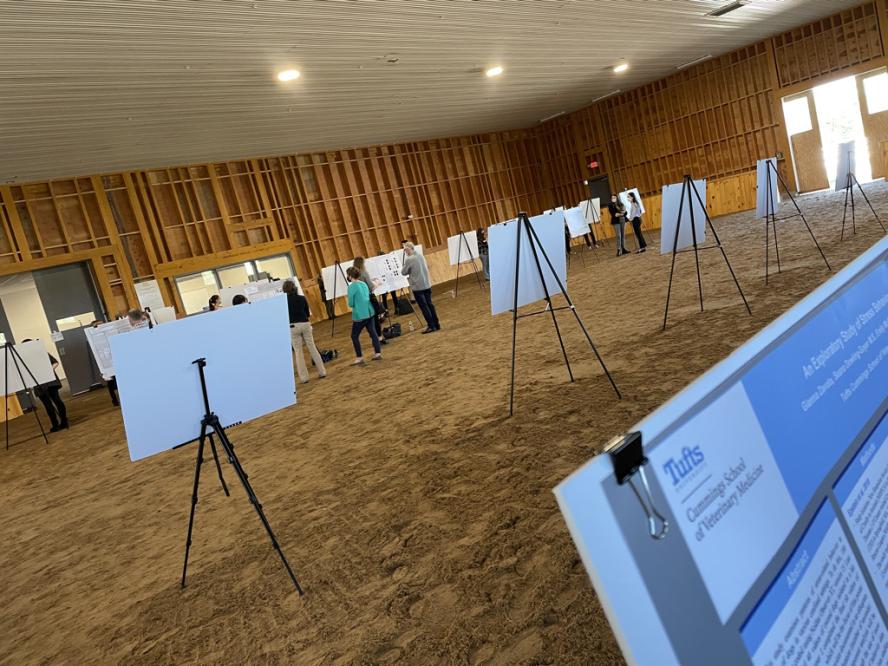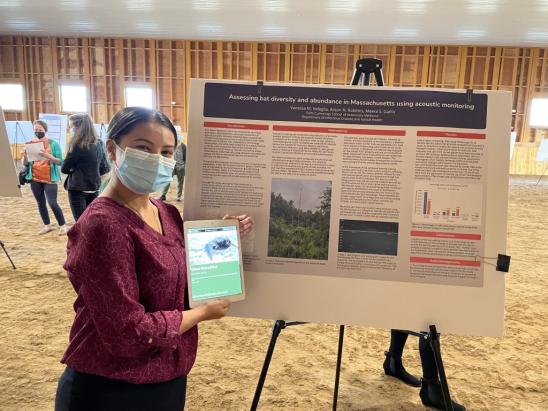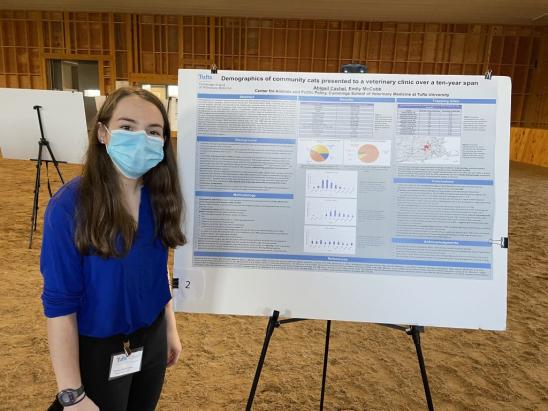-
About
- Leadership & Faculty
- News & Events
-
Academics
- Graduate
- Advanced Clinical Training
- Continuing Education
-
Student Life
-
Research
-
Hospitals & Clinics
- Emergency Care
- Hospital Services
-
Community Outreach
- Volunteer
Veterinary Research Day Winners Announced
32nd Veterinary Research Day showcases exceptional student work

On October 6, Cummings School’s 32nd Veterinary Research Day showcased exceptional student summer research that’s enhanced their expertise and the field at large.
Historically, presentations have been oral, with 20 to 25 students participating; however, this year was reformatted to poster presentations to allow more informal interaction with the community. Graduate students were also welcomed, upping the number of presenters to 34.
The day is unique in that it “provides an opportunity for students to share their experiences and research findings with the entire TUCSVM community,” says Cheryl London, Associate Dean of Research. “This is especially important because we have such a diverse body of research across our school.” Myriad specialties were on display—raising the bar of the competition to new heights. The winners in four categories:
- Abigail Cashel, V24: Demographics of Community Cats Presented to a Veterinary Clinic
Clinical Research - Diana Choi, V23: Creation and Validation of Mycobacterium Tuberculosis Bacilli Recognition Software
Basic Research - Vanessa Indeglia, V23: Assessing Bat Diversity and Abundance in Massachusetts with Acoustic Monitoring
International/Conservation Medicine - Sara Pantel, MAPP: Understanding the Impacts of the COVID-19 Pandemic on Connecticut Dairy Farms
Graduate Student
Understanding the Misunderstood
“Bats have a significant role in our ecosystems as pollinators, seed dispersers, and agricultural crop pest consumers,” Vanessa Indeglia, V23, winner of the international/conservation medicine category, explains. “They also serve as important models for zoonotic viral research.” However, she adds, a recent substantial decline in bat populations has led to a lack of baseline data across North America.
This past summer, Indeglia and fellow researchers conducted acoustic monitoring—recording bat calls via ultrasonic recorders—to pick up on specific bat species see how diversified certain populations were. The team collected more than 21,000 calls, identifying six of nine known species in Massachusetts.
The applied learning experience gave Indeglia a chance to pursue a field she hadn’t worked in but always loved: wildlife. After connecting with bat research veteran Alison Robbins, Assistant Director for the Master’s Program in Conservation Medicine, Indeglia jumped at the chance to work alongside her, incorporating Bat Wonder Spots at the Arnold Arboretum that she hopes will “provide families that visit with a different perspective about an often-misunderstood species.”
While the full research findings aren’t yet complete, she says, “We hope to submit this data to the North American Bat Monitoring program to further future conservation efforts, as well as create educational tools regarding bat species to surrounding Boston communities at the Arboretum.”
Advocating for the Advocates
“There is plenty of Trap-Neuter-Return (TNR) research out there to describe how this practice affects community cat welfare and reduces overpopulation, but little research examines TNR through the lens of clinics, especially in the northeastern United States,” says Abigail Cashel, V24, winner of the clinical research category.
Understanding the makeup of the population is step one. Cashel’s research focuses on gathering data on the male-to-female ratio, pregnancy and lactation rates, and feline infection rates in TNR patients seen by the Tufts Clinic from 2009 to 2019. With millions of cats passing through TNR programs across the country each year, budgeting supplies, labor, and time is vital for overall animal welfare, as well as understanding cat colony characteristics for effective and efficient population management.
Cashel worked as a medical technician at an animal shelter prior to Cummings School and is now a member of the Luke and Lily Lerner Spay/Neuter Clinic. “It is gratifying to see data from our clinic potentially go on to help northeastern TNR organizations more efficiently approach community cat population management,” she says.
Lasting Inspiration
“I was very humbled to hear that I had won,” Cashel adds, “especially given the caliber of the other research presentations at the event.”
Indeglia agrees: “Considering the many astounding research projects presented that day, I was not at all expecting to win. Nonetheless, I was beyond delighted to have won in my category and I am proud of the work I was able to do this summer alongside my mentors.”
London hopes the day helps students continue to be inspired by their summer experience and stay engaged in research during their training and subsequent career. She adds, “They were all amazing!”

